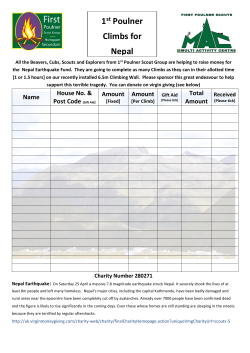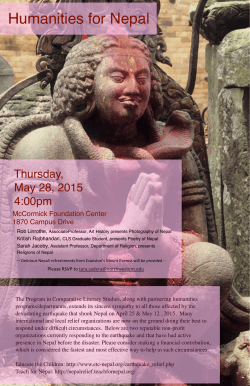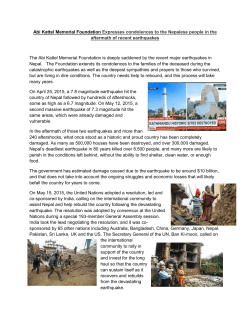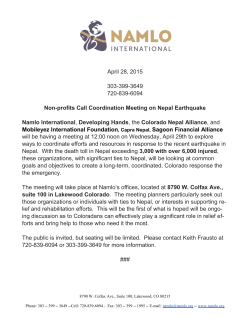
Nepal Earthquake - South African Red Cross Society
Key Messages & Talking Points Nepal Earthquake 28 April 2015 All communication materials are updated regularly on FedNet: http://fednet.ifrc.org/nepaleq Background On 25 April 2015, the lives of hundreds of thousands in Nepal were transformed by one of the worst earthquakes the country had experienced since 1934. The magnitude 7.9 earthquake struck with a depth of 15 kilometres near the capital city of Kathmandu, with the epicentre located 81 kilometres northwest of Kathmandu and 68 kilometres east from Pokhara (the country’s two largest cities), near Lamjung in the Gorkha district. The earthquake - felt as far as Lahore in Pakistan, Lhasa in Tibet and in Dhaka, Bangladesh – left significant damage to buildings, roads and infrastructure. As of 27 April, in Nepal nearly 4,000 people have died, more than 7,000 are injured, 200 are missing and over 5 million people are affected according to ACAPS. More than 500,000 families are displaced, more than 35,000 homes are fully damaged. Tragically, among the deceased are a staff member and two volunteers from the Nepal Red Cross, who were killed during a blood donation drive. In India, more than 60 people were killed in Bihar, Uttar Pradesh and West Bengal, with nearly 300 people injured. In Bangladesh 5 people have died and 100 are reportedly injured. In Tibet, the death toll from the quake rose to 25 with 117 injured according to authorities on 27 April. More than 20,000 have been displaced and more than 10,000 homes and 54 monasteries have been damaged. Numerous aftershocks ranging from magnitude 5.5 to 6.6 continue to rattle the area, causing further damage to buildings and forcing many of the affected population to take shelter in tents and on the streets outside their homes. Electricity and telephone connectivity remains intermittent and mobile services are experiencing heavy congestion, while the number of injured people is exceeding hospital capacities. Both private and government hospitals have no choice but to treat their patients out on the streets. The International Federation of Red Cross and Red Crescent Societies (IFRC) launched a preliminary emergency appeal on Monday 27 April 2015 for the amount of 33.5 million Swiss francs. The appeal will allow the Nepal Red Cross Society deliver critical life-saving assistance to earthquake survivors in Nepal including emergency shelter and basic household items, emergency health and care, livelihoods support, dignified burials and restoring family links services to communities affected by the earthquake. Facts and figures 4000+ dead 7000 injured 200 missing 5 million affected More than 500,000 displaced 35,000 homes damaged Source: ACAPS available here http://www.acaps.org/en/pages/what-is-acaps Key messages International Federation of Red Cross and Red Crescent Societies 2 I Key Messages and talking points / Nepal Earthquake / 28 April 2015 The International Red Cross and Red Crescent Movement are mobilizing our global resources to assist affected population, working alongside and in support of Nepal Red Cross Society.More than 1,500 volunteers and 300 staff of the Nepal Red Cross Society continue to work around the clock in extending first aid, transporting the wounded to hospitals, supporting search and rescue efforts, and providing temporary shelter to those affected. These humanitarian services are being implemented in coordination and cooperation with the Government of Nepal, communities, UN agencies, and International Red Cross and Red Crescent Movement partners. The humanitarian situation remains extremely serious. Although some roads from the capital, Porkhara and Gorkha are reportedly accessible, many areas remain difficult to access and as a result, the full picture is still unclear. Electricity in Katmandu has been partially restored, and telecommunication networks are intermittently operating. Large numbers of people are still staying in open space and water a sanitation remain a major concern. Understanding that people suffer terribly when they lose contact with their loved ones and don't know where they are or whether they are safe, the Nepal Red Cross Society, supported by the International Committee of the Red Cross (ICRC), is maintaining a website in English and Nepali to restore contact between those who have been separated. People who are looking for someone or who would like to inform that they are safe can register their details at: http://familylinks.icrc.org/nepal-earthquake. The website is continuously updated as soon as information is verified. Red Cross Red Crescent response The Nepal Red Cross Society has been responding from the onset of the disaster. More than 1,500 Red Cross volunteers and 300 staff have been working relentlessly, supporting search and rescue efforts, providing first aid and psychosocial support, carrying out assessments, and assisting at evacuation centres and on the streets, distributing oral rehydration salts, aqua tabs, and tarpaulins. Before the earthquake, the Red Cross had approximately 19,000 relief kits pre-positioned in Nepal. These supplies will help drive the initial response, but more support will be needed. In addition to supporting search and rescue and relief efforts in Kathmandu, Red Cross teams are working with authorities to reach towns and villages closer to the epicentre of the quake (between Kathmandu and Pokhara), and across the more than 30 districts affected – including many remote villages and communities. We estimate that IFRC actions are currently reaching more than 10,000 people directly affected by the earthquake with relief items and first aid assistance. The IFRC is mobilizing a massive response to support the Nepal Red Cross Society and the people affected by this disaster. We have activated our disaster response systems in Kuala Lumpur and Nepal. We have relief supplies, sufficient for approximately 50,000 families, pre-positioned throughout Asia Pacific. On Saturday, the day of the earthquake, the IFRC released 500,000 Swiss francs from our Disaster Relief Emergency Fund (DREF) to support initial response efforts and assessments. The IFRC has deployed a Field Assessment and Coordination Team (FACT) to lead assessments and support the Nepal Red Cross to direct the first waves of international assistance. This team is already on the ground or is en route. 15 helicopters are available (supported by Airbus) for assessments. The IFRC is charting three planes laden with supplies. The first, carrying shelter tool kits, jerry cans, tarpaulins, kitchen sets, hygiene kits and blankets for 200 families, is expected to fly from Kuala Lumpur on Wednesday. International Federation of Red Cross and Red Crescent Societies 3 I Key Messages and talking points / Nepal Earthquake / 28 April 2015 In coordination with our members around the world, we are also deploying seven Emergency Response Units (more may follow) to be operational this week. These include: o o o o o A rapid deployment hospital (Norwegian Red Cross) Two basic health care units (Philippine Red Cross/Canadian Red Cross and Japanese Red Cross). The advance team for the first unit is deploying today, the other during the week. An emergency relief unit (Danish Red Cross/American Red Cross) Two logistic units (Swiss Red Cross and Finnish Red Cross/Danish Red Cross) An IT unit that includes VSAT (satellite connectivity) (New Zealand Red Cross/American Red Cross) Regional disaster response teams from South Asia, South East Asia and East Asia have also been deployed and will be arriving in Kathmandu when possible. The IFRC is cooperating closely with the International Committee of the Red Cross (ICRC) to ensure support to the Nepal Red Cross Society in the key areas of restoring family links (RFL) and dignified dead body management. As part of the needs assessment teams organized by the IFRC, the ICRC has sent a forensic expert and a restoring family links expert to Nepal. The ICRC also provided a set of dressing modules to two hospitals in Kathmandu which is sufficient to treat approximately 300 injured people. On Monday 27 April, 700 body bags were given by the ICRC Delhi to the IRCS for dispatch to Kathmandu; another two hundred body bags have been handed over to the Department of Forensics Medicine, Tribhuvan University Teaching Hospital. In support of the strong coordination efforts of the Government of Nepal and the international humanitarian system – the IFRC and NRCS will lead cluster coordination for the Shelter and Settlements sector. The Red Cross is also monitoring and assessing humanitarian needs resulting from the impact of the earthquakes in neighboring countries including in India and Tibet.The Red Cross Society of China has delivered 2,000 tents to those affected by the earthquake in Tibet, and additional relief items such as quilts, warm clothing and blankets are expected in the coming days. Social media Since the Nepal earthquake struck, millions of individuals around the world including humanitarian organizations, media, and government representatives are engaging in conversations on social media. As a global Movement, the Red Cross Red Crescent has an opportunity to take part in this global conversation and reach millions of people with effective messaging that can support awareness raising and fundraising efforts. We need to ensure consistency in our communication messages, speaking with one voice and one Red Cross and Red Crescent Movement across our different communication channels and languages. To manage this, we encourage you to: Use the hashtag #NepalQuake in all your tweets and social media posts (Spanish: #TerremotoNepal). Remember to also hashtag the word #Nepal if you are including the word in your tweet / post. This will enable our messages to be included in the ongoing conversations on the topic globally. This is the standard hashtag being promoted by other reputable sources present on the ground (e.g. UN, OCHA, Save the Children, WFP, CNN). If you are tweeting in other languages, it is recommended that you also use the English hashtag where possible. International Federation of Red Cross and Red Crescent Societies 4 I Key Messages and talking points / Nepal Earthquake / 28 April 2015 In order to track and monitor the exposure or coverage of the Movement’s messages and conversations on social media, we encourage you to include the hashtag #RedCross or #RedCrescent in your messages/ posts. Talking points Q. What are the main needs right now? Talking point: More than 72 hours after the earthquake, the focus remains on continuing to work with everyone on the search-and-rescue efforts, as well as providing first aid and tarpaulins as a measure of shelter. We are extremely concerned for all of those affected, particularly in rural areas that are hard to reach. Q. What are the main challenges right now? Talking point: With 30 districts affected, currently it is difficult to access many areas where people are in need of help. We are extremely concerned about these communities. Time is critical and while we conduct search-and-rescue alongside everyone else in Kathmandu, we also have Red Cross teams working with authorities to reach villages that are closer to the epicenter of the quake. Q. What will the appeal be used for? Talking point: The appeal will allow the Red Cross to support 75,000 people through the coming days and months with emergency shelter and health care. It will also help the Red Cross provide dignified burials and restore family links for those separated from their loved ones. This appeal is preliminary and reflects the situation as we understand it now, based on the information available at this stage. There are still areas where we haven’t been able to reach. As more information becomes available, we will revise our plans and our budget, and will most likely revise this amount based on the needs of the affected population. We are calling on all our partners and donors to urgently and generously support the appeal. For further information, please contact: In Kathmandu Mark South, British Red Cross delegate Tel: +9779813102044 / Msouth@redcross.org.uk Twitter: @78Southy Patrick Fuller, IFRC Asia Pacific communication manager Tel +60122308451 / +881622418536 / Patrick.fuller@ifrc.org Twitter: @pat_fuller and @IFRCAsiapacific Nichola Jones, IFRC communications delegate Tel +447793167032 / Twitter @nicjones81 In New Delhi Maude Froberg, IFRC regional communication manager Tel +918130918887 / maude.froberg@ifrc.org Twitter: @maudefroberg In Kuala Lumpur Kate Roux, IFRC regional communication manager Tel: +66 81 376 5107 / Katherine.roux@ifrc.org Twitter @katherineroux In Geneva Benoit Carpentier, IFRC external communications +41792132413 Email: benoit.carpentier@ifrc.org Twitter: @BenoistC Follow @Federation and @IFRCAsiapacific for updates on the Nepal earthquake response and reference the hastag #NepalQuake
© Copyright 2025









